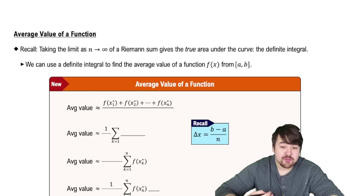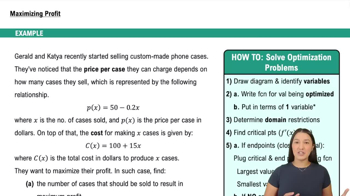Parabolic motion An arrow is shot into the air and moves along the parabolic path y=x(50−x) (see figure). The horizontal component of velocity is always 30 ft/s. What is the vertical component of velocity when (a) x=10 and (b) x=40? <IMAGE>
Table of contents
- 0. Functions7h 54m
- Introduction to Functions16m
- Piecewise Functions10m
- Properties of Functions9m
- Common Functions1h 8m
- Transformations5m
- Combining Functions27m
- Exponent rules32m
- Exponential Functions28m
- Logarithmic Functions24m
- Properties of Logarithms36m
- Exponential & Logarithmic Equations35m
- Introduction to Trigonometric Functions38m
- Graphs of Trigonometric Functions44m
- Trigonometric Identities47m
- Inverse Trigonometric Functions48m
- 1. Limits and Continuity2h 2m
- 2. Intro to Derivatives1h 33m
- 3. Techniques of Differentiation3h 18m
- 4. Applications of Derivatives2h 38m
- 5. Graphical Applications of Derivatives6h 2m
- 6. Derivatives of Inverse, Exponential, & Logarithmic Functions2h 37m
- 7. Antiderivatives & Indefinite Integrals1h 26m
- 8. Definite Integrals4h 44m
- 9. Graphical Applications of Integrals2h 27m
- 10. Physics Applications of Integrals 3h 16m
- 11. Integrals of Inverse, Exponential, & Logarithmic Functions2h 31m
- 12. Techniques of Integration7h 41m
- 13. Intro to Differential Equations2h 55m
- 14. Sequences & Series5h 36m
- 15. Power Series2h 19m
- 16. Parametric Equations & Polar Coordinates7h 58m
4. Applications of Derivatives
Related Rates
Problem 30b
Textbook Question
Consider the following cost functions.
b. Determine the average cost and the marginal cost when x=a.
C(x) = 500+0.02x, 0≤x≤2000, a=1000
 Verified step by step guidance
Verified step by step guidance1
To find the average cost, we need to divide the total cost function C(x) by the number of units x. The average cost function A(x) is given by A(x) = C(x) / x.
Substitute the given cost function C(x) = 500 + 0.02x into the average cost formula: A(x) = (500 + 0.02x) / x.
Simplify the expression for A(x): A(x) = 500/x + 0.02.
To find the average cost at x = a, substitute a = 1000 into the average cost function: A(1000) = 500/1000 + 0.02.
The marginal cost is the derivative of the cost function C(x) with respect to x. Differentiate C(x) = 500 + 0.02x to find C'(x), which is the marginal cost. Since C(x) is linear, C'(x) = 0.02. The marginal cost at x = a is simply C'(1000) = 0.02.
 Verified video answer for a similar problem:
Verified video answer for a similar problem:This video solution was recommended by our tutors as helpful for the problem above
Video duration:
3mPlay a video:
Was this helpful?
Key Concepts
Here are the essential concepts you must grasp in order to answer the question correctly.
Cost Functions
A cost function represents the total cost incurred by a firm in producing a certain quantity of goods, denoted as C(x). In this case, C(x) = 500 + 0.02x indicates that there is a fixed cost of 500 and a variable cost that increases linearly with the quantity produced (x). Understanding the structure of cost functions is essential for analyzing production costs.
Recommended video:

Properties of Functions
Average Cost
The average cost is calculated by dividing the total cost by the quantity produced, expressed as AC(x) = C(x)/x. It provides insight into the cost per unit of production. For the given cost function, calculating the average cost at x = a (where a = 1000) will help determine how efficiently resources are being utilized at that production level.
Recommended video:

Average Value of a Function
Marginal Cost
Marginal cost refers to the additional cost incurred by producing one more unit of a good, mathematically represented as MC(x) = C'(x). It is derived from the derivative of the cost function. For the provided cost function, finding the marginal cost at x = a (x = 1000) will indicate how production costs change with incremental increases in output, which is crucial for decision-making in production.
Recommended video:

Example 3: Maximizing Profit

 4:16m
4:16mWatch next
Master Intro To Related Rates with a bite sized video explanation from Patrick
Start learningRelated Videos
Related Practice
Textbook Question
